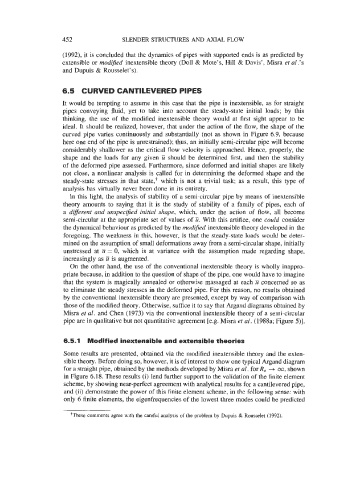Page 481 - Fluid-Structure Interactions Slender Structure and Axial Flow (Volume 1)
P. 481
452 SLENDER STRUCTURES AND AXIAL FLOW
(1992), it is concluded that the dynamics of pipes with supported ends is as predicted by
extensible or modified inextensible theory (Doll & Mote’s, Hill & Davis’, Misra er al.’s
and Dupuis & Rousselet’s).
6.5 CURVED CANTILEVERED PIPES
It would be tempting to assume in this case that the pipe is inextensible, as for straight
pipes conveying fluid, yet to take into account the steady-state initial loads; by this
thinking, the use of the modified inextensible theory would at first sight appear to be
ideal. It should be realized, however, that under the action of the flow, the shape of the
curved pipe varies continuously and substantially (not as shown in Figure 6.9, because
here one end of the pipe is unrestrained); thus, an initially semi-circular pipe will become
considerably shallower as the critical flow velocity is approached. Hence, properly, the
shape and the loads for any given U should be determined first, and then the stability
of the deformed pipe assessed. Furthermore, since deformed and initial shapes are likely
not close, a nonlinear analysis is called for in determining the deformed shape and the
steady-state stresses in that state,+ which is not a trivial task; as a result, this type of
analysis has virtually never been done in its entirety.
In this light, the analysis of stability of a semi-circular pipe by means of inextensible
theory amounts to saying that it is the study of stability of a family of pipes, each of
a different and unspeciJied initial shape, which, under the action of flow, all become
semi-circular at the appropriate set of values of U. With this artifice, one could consider
the dynamical behaviour as predicted by the modified inextensible theory developed in the
foregoing. The weakness in this, however, is that the steady-state loads would be deter-
mined on the assumption of small deformations away from a semi-circular shape, initially
unstressed at U = 0, which is at variance with the assumption made regarding shape,
increasingly as U is augmented.
On the other hand, the use of the conventional inextensible theory is wholly inappro-
priate because, in addition to the question of shape of the pipe, one would have to imagine
that the system is magically annealed or otherwise massaged at each U concerned so as
to eliminate the steady stresses in the deformed pipe. For this reason, no results obtained
by the conventional inextensible theory are presented, except by way of comparison with
those of the modified theory. Otherwise, suffice it to say that Argand diagrams obtained by
Misra et al. and Chen (1973) via the conventional inextensible theory of a semi-circular
pipe are in qualitative but not quantitative agreement [e.g. Misra et al. (1988a; Figure 5)].
6.5.1 Modified inextensible and extensible theories
Some results are presented, obtained via the modified inextensible theory and the exten-
sible theory. Before doing so, however, it is of interest to show one typical Argand diagram
for a straight pipe, obtained by the methods developed by Misra et al. for R, +. 00, shown
in Figure 6.18. These results (i) lend further support to the validation of the finite element
scheme, by showing near-perfect agreement with analytical results for a cantilevered pipe,
and (ii) demonstrate the power of this finite element scheme, in the following sense: with
only 6 finite elements, the eigenfrequencies of the lowest three modes could be predicted
+These comments agree with the careful analysis of the problem by Dupuis & Rousselet (1992).

